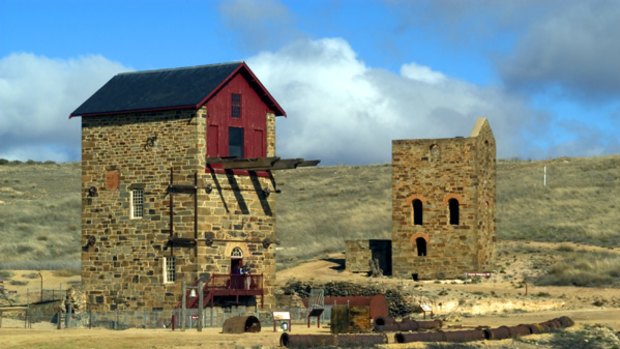
Morphett's Enginehouse Museum.Credit: Diana Mayfield/Lonely Planet
Wandering around Burra, 160 kilometres north of Adelaide, there's little evidence that its population was once more than Brisbane and Perth combined. Now a sleepy town of 2200, what does remain of those boom years is a treasure trove of lovingly maintained historic sites.
On a quiet Wednesday morning, there's a sprinkling of visitors in Burra's tea rooms. Many rooms double as antique shops where tea and scones are accompanied by a hunt for china, crystal glassware, clocks and old furniture.
Signing up for the self-guided Burra Heritage Passport trail at the Burra Visitors Centre, I'm given a key that opens eight historic sites and a guidebook with details of 65 other sites in the region, plus a walking guide to Market Square.
In the square, my tour begins with coffee and cake at Gaslight Collectables and Old Books.
I strike up a conversation with Steve Boyes, a mining engineer from Cornwall, who was driving through South Australia on a holiday several years ago and was attracted to the history and ambience of Burra. Boyes' three-night visit became a permanent move.
From Boyes, I learn Burra's copper mine was one of the richest in the world. Discovered in 1845 by Thomas Pickett, it attracted miners from across Europe and Britain - but mostly from Cornwall.
Around the same time, William Streair discovered copper nearby. Pickett and Streair hooked up with two rival companies, one nicknamed The Nobs (pastoralists who formed the Princess Royal Mining Company); the other nicknamed The Snobs (South Australia Mining Association).
Neither Nobs nor Snobs could individually raise enough money to buy the land where the mines were discovered, so they joined forces and purchased the land together.
The Nobs and Snobs drew lots and the South Australia Mining Association ended up controlling the Monster Mine, which by 1850 became Australia's largest metal mine.
The walking trail around Market Square takes in churches, the telegraph station and post office and the Burra Hotel, built in 1847. I can easily picture rowdy Cornish miners spilling out of the hotel and into a brawl in the dusty street. In those days, things were pretty rough - the Burra Police Lockup and Redruth Gaol were among the first law-enforcement structures built in regional South Australia.
My key lets me into Redruth Gaol. Not a lot has changed since it was a prison for 30 men and women. The wooden floors are uneven and you can still see the broken glass on the walls of its exercise yard, placed there to stop the prisoners from escaping.
Miners swarmed into Burra hoping to make a fortune - causing an accommodation problem. The short-term solution was to excavate dugouts in the bank of the Burra Creek, providing instant living quarters for miners and their families. Over the years, the creek has washed away most of the dugouts but a few remain. The dugouts stretched for five kilometres and became home to 1600 people.
Lucky families moved in to cottages - some of Australia's first company-built housing. One such place is the Paxton Square Cottages, which can be rented for an overnight stay.
Most of Burra's buildings were made from local blue stone and each migrant group built separate villages, each with its own shops and schools. The Cornish lived in Redruth, the Scots in Aberdeen, the Welsh in Llwchwr and the English in Hampton. Although there's nothing left of Hampton village, historic houses in other villages have been renovated.
Burra's main attraction is the Monster Mine itself and Morphett's Engine House Museum. The tall, stone Morphett's building houses a working pump engine, old photographs and a mine tunnel open to the public.
The Monster Mine's crater, with its glistening emerald waters and 80-metre walls, provides wonderful acoustics for the Jazz in the Monster Mine show held each February.
The Unicorn Brewery supplied beer to Burra's areas. The brewery's maze of cellars is a cool spot to wander when the mercury starts to rise.
Another cool spot is where I'm staying - in the well-appointed Burra Rendez-Vous Luxury Accommodation, a contemporary cottage with stainless steel kitchen appliances, state-of-the-art surround sound system and a lovely double-spa tub. As I lather myself with red papaya foam while sipping a chilled glass of Clare Valley Riesling, I ponder the hardships the miners put themselves and their families through. The mine's lode life was just 32 years.
The writer was a guest of the South Australian Tourism Commission.
TRIP NOTES
Qantas, Virgin Blue and Jetstar fly to Adelaide. Hire a car to drive to Burra.
The Burra Heritage Passport unlocks eight key sites. It comes with a guidebook to 65 other sites that can be explored on an 11-kilometre driving trail. The self-guided tour is available seven days a week from the Burra Visitor Centre. Phone (08) 8892 2154, see visitburra.com.
Burra Rendez-Vous. Phone (08) 8892 2057, see burrarendezvous.com.au. Rates start at $205 a night, includes breakfast. Burra Heritage Cottages has two-bedroom cottages from $135. Phone (08) 8892 2461.
More information
See southaustralia.com.
Sign up for the Traveller Deals newsletter
Get exclusive travel deals delivered straight to your inbox. Sign up now.